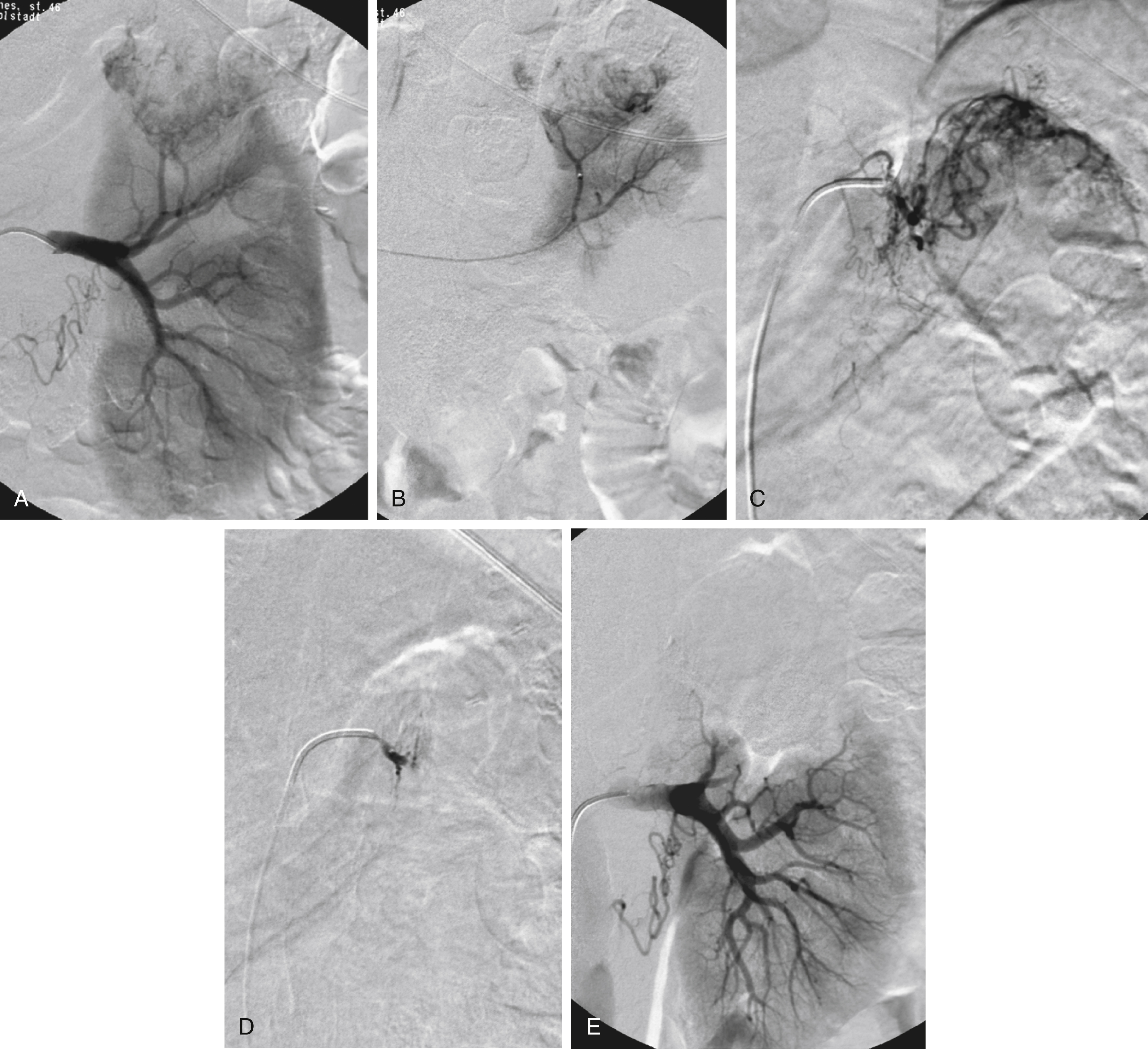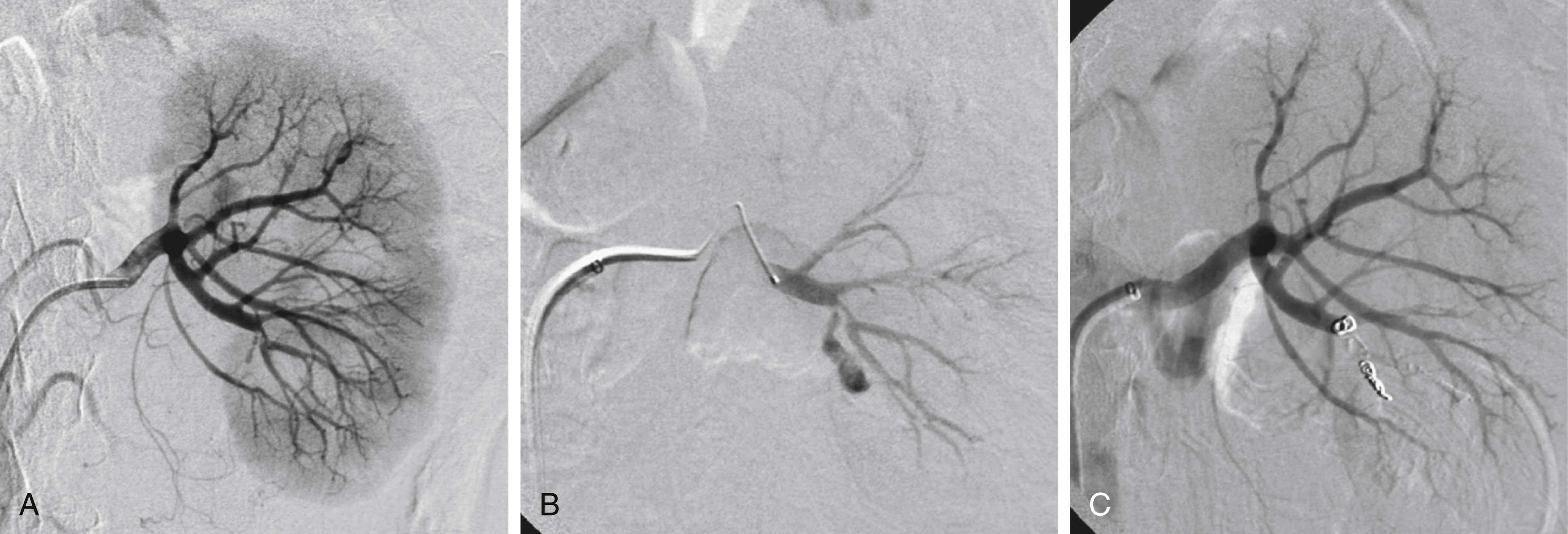Physical Address
304 North Cardinal St.
Dorchester Center, MA 02124
Embolotherapy of the renal arteries was introduced into the portfolio of the interventional radiologist many years ago. It was most popular in the 1980s and 1990s when preoperative embolization of kidneys containing a renal cell carcinoma (hypernephroma) was widely used as a routine procedure in the belief that preoperative embolization might avoid tumor seeding during surgery. Because no oncological benefit has since been proved by this strategy, and blood loss is no longer a major problem in renal surgery, preoperative embolization is now limited to a few uncommon circumstances. Nevertheless, many different techniques were developed, resulting in the current array of indications for renal embolotherapy.
Total renal embolization is indicated for inoperable hypernephromas in patients with persistent hematuria or severe paraneoplastic symptoms such as hypercalcemia (Stauffer syndrome). In these patients, complete embolization of the tumor-bearing kidney is indicated if a functioning contralateral kidney is still present. Some groups prefer tumor embolization even without symptoms to reduce tumor bulk in combination with immunostimulating therapies. In total embolization not followed by nephrectomy, embolization should be performed by particles of small diameter or bucrylate–ethiodized oil mixed in a ratio of 1:3 to 1:5 to allow deep deposition into the tumor tissue.
Preoperative embolization is still indicated in a small subset of tumors, especially those that have developed extensive venous involvement. Preoperative embolization may be indicated as a safety procedure in patients who refuse blood transfusions, such as Jehovah’s Witnesses. In preoperative embolization, the technique is modified because only occlusion of the main renal artery is necessary. This can be achieved by coils, Amplatzer plugs (Abbott, Abbott Park, IL), or bucrylate–ethiodized oil mixed in a ratio of 1:1 to 1:3 to achieve rapid occlusion of the main renal artery.
Partial tumor ablation by embolization ( Fig. 32.1 ) is preferred in patients who have a tumor in a single functioning kidney. Partial embolization has also been used as a preparation for thermal ablation of a circumscribed peripheral malignant tumor to reduce the risk of postprocedural bleeding after radiofrequency ablation or to enhance its efficacy.

There is more published experience of renal artery embolization for ruptured or bleeding benign renal tumors such as angiomas and particularly angiomyolipomas. The latter have a tendency to grow during pregnancy, and prophylactic embolization may be performed in women who wish to become pregnant to prevent major bleeding during pregnancy. In benign lesions, a partial embolization is preferable whenever possible.
As an alternative to partial embolization, advanced surgical techniques such as partial nephrectomy—either open or laparoscopic—and radiofrequency ablation have been described.
Total renal embolization, including bilateral embolization in some cases, may be indicated in patients with massive protein loss in nephrotic syndrome or other complications of end-stage renal failure such as intractable hypertension. Other indications for total renal embolization are failing kidney transplants, as an alternative to surgical removal in cases of graft intolerance syndrome, and persistent urinary leaks in failing kidneys.
Very rarely, partial defunctionalization has been described in cases with segmental arterial stenosis and hypertension in which the responsible segmental artery was embolized. Alternatively, these patients may undergo intrarenal percutaneous transluminal angioplasty using small balloons.
Blunt or direct trauma may cause renal bleeding due to renal laceration or renal artery rupture. Trauma may also cause renal artery pseudoaneurysms, arteriovenous fistulas combined with hematuria, direct hemorrhage into the pelvicalyceal system, or development of perirenal hematomas.
Unfortunately, the main causes of traumatic renal hemorrhage are iatrogenic in origin and represent the majority of cases of traumatic renal hemorrhage in Europe. They include renal biopsies in native and transplant organs, percutaneous techniques such as percutaneous nephrostomy ( Fig. 32.2 ), nephrolithectomy, and percutaneous transluminal renal angioplasty, where direct arterial perforation by the guidewire tip has been described. Also, indirect methods such as shockwave lithotripsy can lead to renal trauma requiring embolotherapy.

Although iatrogenic hemorrhage is relatively common, few cases require treatment (0.3%–1% of percutaneous renal interventions and 0.5% of percutaneous biopsies ). Moreover, although hemorrhage that requires treatment is unusual, temporary, and self-limiting, bleeding or arteriovenous fistulas occur in up to one-third of percutaneous renal procedures. Since the introduction of partial nephrectomy techniques, bleeding after partial surgery has become a significant cause of iatrogenic hemorrhage. Approximately 2% of patients who undergo partial nephrectomy develop postsurgical bleeding, and most of them require percutaneous embolization.
Direct stab wounds, bullet wounds, and motor vehicle accidents are other traumatic causes of renal injury. Embolotherapy is the treatment of choice in patients who (1) are not controlled by conservative management and (2) do not have complete central laceration of the renal arteries, which requires surgery.
Rarely, benign tumors such as angiodysplasias, angiomas, or angiomyolipoma ( Fig. 32.3 ) may cause spontaneous—sometimes substantial—bleeding (Wunderlich syndrome) and may undergo embolization. In a few cases, they may also develop hypertension.

As a special problem, true and false aneurysms of the mainstem renal artery may occur that may be symptomatic or not, have an unknown risk for rupture, and usually grow slowly but may also serve as an embolic source for renal infarction. There is a general consensus that a diameter of 20 mm is a threshold for treatment; smaller aneurysms may undergo treatment if symptomatic. Central renal artery aneurysms require treatment by coil placement or, if possible, exclusion by the use of stent grafts.
Peripheral (pseudo)aneurysms may be due to trauma or systemic diseases such as polyarteritis nodosa. Peripheral aneurysms are best treated by exclusion, coil placement, or medical adhesive (cyanoacrylate, “glue”) deposition. The most difficult location for treatment of renal artery aneurysms is at the site of a renal artery bifurcation (or trifurcation), because exclusion of the aneurysm may require occlusion of one or more segmental arteries. A combination of bare metallic stents with coils, glue, Onyx (ethylene vinyl alcoholic copolymer [ev3/Covidien, Plymouth, MN]), or flow-diverting stents may be an option in these challenging locations.
There are few absolute contraindications to total or selective renal artery embolization. Embolization should be avoided in the presence of acute infection to avoid superimposed infection of the devascularized territories.
Relative contraindications are impaired global renal function, allergic reactions to contrast media, acute hyperthyroidism, planned radioiodine therapy, and single kidneys. In the latter, embolization may be performed if no other nephron-sparing surgical alternative exists.
A modern angiographic unit (preferably with the possibility of pulsed fluoroscopy and 3D imaging) and experience with coaxial catheters, microcatheters, and a variety of different embolization agents (e.g., glue, particles, coils) are required.
Become a Clinical Tree membership for Full access and enjoy Unlimited articles
If you are a member. Log in here